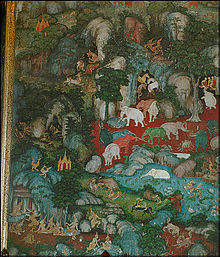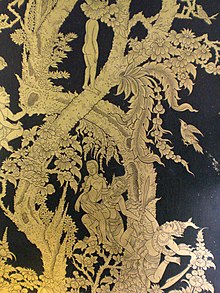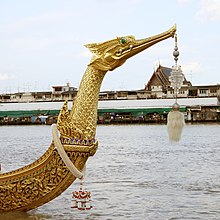Himavanta

Himavānta ( Sanskrit and Pali for "snowy [mountains]"; Thai ป่า หิมพานต์ , RTGS Pa Himmaphan , also Himaphan ; Khmer : Himapean , Burmese Himawunta , meaning the same as the Himalayas ) is a forest area from Hindu and Buddhist mythology , which is particularly used in art and literature from the countries of the Southeast Asian mainland ( Myanmar , Thailand , Cambodia , Laos ). It is located on the slopes of the world mountain Meru , the central axis of the Buddhist world. Mount Meru is located in the northern part of the Jambu continent .
location
In the Thai cosmology Traiphum Phra Ruang from the 14th century, the Himaphan forest is localized as follows: In the great salt ocean between the Iron Mountains and the seven mountain ranges that surround Mount Meru, there are four continents: Pubbavideha in the east , in the north Uttarakuru , in the west Aparagoyana and in the south the Jambu continent ( Sanskrit Jambudvipa , Thai: ชมพูทวีป - "Chomphuthawip"), on which the people live. Jambudvipa means "continent of the jambu fruits", these are sweet, large fruits that ripen on the jambu tree of life . The same tree is called Jambi in Tibet and Zambu by the Mongols .
In the north of the Jambu continent lies the Himaphan Forest in the Himaphan Mountains. The Himaphan Mountains are 500 yojana high. They stretch over 3,000 yojana and have 84,000 mountain peaks.
description

There are many miraculous trees in the Himaphan Forest, such as the virgin tree, which instead of fruit bears young girls. They are like girls who have just turned 16. When men see them, they instantly fall in love. When they fall to the ground, many birds gather to eat them, like bears feasting on honey.
At the foot of the Himaphan Mountains there are seven large bodies of water that never become cloudy or even dry out. Some of them are covered with beautiful plants, various types of lotus and water lilies. One of these bodies of water is called Anotatta Lake . There are five mountain ranges near Lake Anotatta, all of which are 200 yojana high. One of these mountains is called Kelasa (cf. Kailash ), where the Kinnaris live. The five mountain ranges are rich in many special gemstones. Swans and elephants live here.
Four rivers originate in Lake Anotatta and flow around the lake three times before flowing northeast, northwest, southwest and south until they flow into the great salt ocean. The southern river, after making its way through the mountain ranges, splits into 5 large rivers, like fingers on a hand. One is called Ganga , another Yamuna , an Aciravati , a Mahi, and a Sarabhu . These rivers flow through people's lands before flowing into the ocean.
The birds and the other animals of the Himaphan Forest come to drink at Lake Anotatta. There are four huge gargoyles at the edge of the lake. The gargoyles are shaped like animal heads: a bull, a horse, an elephant and a lion. The water from these gargoyles first flows around Lake Anotatta three times before flowing into an ocean. The water from one of the four gargoyles first flows three times around the lake. It is called Avatta-Ganga and is 4,000 Wa wide. After about 480,000 Wa it hits a mountain where it shoots up 60 yojana and then 6,000 Wa around the mountain and it is now called Akasan-Ganga . It then falls onto a rock called Tiyaggala Rock , where it forms a lake called Tiyaggala Lotus Lake . It continues flowing out of Lotus Lake for 480,000 Wa and passes through rocky terrain where it is called Bahala-Ganga . For another 480,000 Wa, it flows underground, called Ummagga-Ganga . Then it meets the Vijjha Natirag Chana Mountain , where it emerges again from the underground to form the five great rivers of the ancient Asian world: the Ganga ( Ganges ), the Aciravati ( Irrawaddy ), the Sarabhu (Salween), the Mahi and the Yamuna (Jumna).
Creatures

There are many strange animals in the Himaphan Forest. In addition to the garudas , the nagas , swans (haṃsa) and birds, there are, for example, the precious stone elephants, whose family is called Chaddanta . The representatives of this family are worthy to serve as a mount for a Chakravartin (a universal ruler of the world). They are big and strong and their bodies are white as the moonlight on a full moon night, their feet are red and beautiful as the rising sun, and their trunks are red and beautiful as a red lotus. They can travel swiftly through the air like perfect saints. They move through the air like the Royal Golden Swan. These elephants are as big as a silver mountain created by Vissukhamma. They are tame and experienced like really old elephants.
Also worth mentioning is the Sindhava family of gem horses, whose king is called Valakha . They are white like the clouds or the fog and they are surrounded by a greenish aura like lightning. The hair on their heads is black and shiny like a crow's neck, it shines like a sapphire. Her mane is white and soft and shimmers like the moon and it moves in the wind as elegantly as stalks made of plong grass. They too can fly through the air like hermits using their magical powers to fly.
Representation in art
The descriptions of these animals in the Traiphum Phra Ruang have inspired generations of Thai artists to depict them on stage, for example, or to depict them in great paintings on the walls of sacred buildings in temples in praise of the Buddha. A wonderful example should be mentioned here: the painting on the eastern wall of the Ubosot in Wat Suthat in Bangkok. Here you can see the richness of the mythical creatures in the Himaphan Forest.
In Myanmar, the scenic representation of the Himawunta Forest marks the opening of the traditional Yoke thé puppet theater .
literature
- Frank E. Reynolds, Mani B. Reynolds (transl.): Three worlds According To King Ruang . Berkeley, 1982. ISBN 0-89581-153-7
Web links
- Himmapan Creatures - an overview of the various mythical animals of the Himaphan forest with many pictures
Individual evidence
- ^ John Falconer: Burmese Design and Architecture. Periplus, Hong Kong 2000, p. 150.
- ↑ Patricia Herbert: Burmese cosmological manuscripts. In: Burma. Art and Archeology. British Museum Press, London 2002, pp. 77–97, on p. 89 ff.
- ^ U Khin Zaw: Burmese Culture. General and Particular. Sarpay Beikman, Rangun 1981, pp. 17-19
- ^ Henry Ginsburg: Thai Art and Culture. Historic Manuscripts from Western Collections. British Library, London 2000, p. 135.
- ↑ Ashley Thompson: Buddhism in Cambodia. Rupture and Continuity. In: Buddhism in World Cultures. ABC-CLIO, Santa Barbara CA 2006, pp. 129-167, at p. 154.
- ↑ Wajuppa Tossa: Lao Folktales. Libraries Unlimited, Westport CT 2008, p. 137.
- ↑ A yojana (in Thai : โยชน์ ) is an ancient measure of length. It is about 16 km.
- ^ Three Worlds According to King Ruang. A Thai Buddhist Cosmology. Translated and annotated by Frank E. Reynolds, Mani B. Reynolds. University of California, Center for South and Southeast Asian Studies, Berkeley 1982, p. 290
- ↑ A Wa is also an old measure of length. 1 yojana contains 8000 Wa. So 1 Wa is about 2 meters.